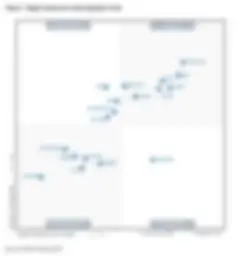Our reflections on the 2021 Gartner® Magic Quadrant™ for Data Integration Tools
By Talend Team


“The data integration tool market is seeing renewed momentum, driven by requirements for hybrid and multi-cloud data integration, augmented data management, and data fabric designs.” This is what Gartner assesses in its latest Magic Quadrant for Data Integration Tools* report.
And that assessment makes perfect sense. Data is the lifeblood of an organization. However, according to Harvard Business Review, the most common complaint from people in different parts of a business is that it’s difficult to obtain even the most basic data. Without data, leaders cannot make informed decisions, thus putting the success – and many times the very existence – of the business in peril.
To make data accessible to everyone in an organization, choosing the best data integration solution is essential. But today, integration is about more than just moving data around. In its research, Gartner notes that “organizations are increasingly seeking a comprehensive range of improved data integration capabilities to modernize their data, analytics, and application infrastructures.” These capabilities include ETL and ELT, API integration, self-service data preparation, and cloud migration.
Data integration plays a vital role for organizations on their journey to achieve healthier data — data that supports effective decision-making and helps companies meet their business objectives. And organizations who do not implement the right data integration strategy — or choose the right data integration solution — will be left behind.
A unified approach to data integration
To ensure the success of business-critical data initiatives, partnering with a trusted, experienced leader with a proven track record of success is of the utmost importance.
That’s why we are thrilled to be recognized – for the sixth year in a row – as a Leader in the 2021 Gartner Magic Quadrant™ for Data Integration Tools report. This year Gartner evaluated Talend alongside 17 other vendors based on their completeness of vision and ability to execute.


According to Gartner research, “Data integration teams (in terms of individual members) are constantly contracting — the median number of individuals in teams is less than 15 (based on anecdotal evidence from our inquiries). And while team sizes are reducing, the amount of data and, hence, the number of data integration requirements are growing exponentially.” We believe these challenges can be substantially addressed with a data fabric. Gartner says “a data fabric is an architecture pattern that informs and automates the design, integration and deployment of data objects regardless of deployment platforms or architectural approaches. This approach results in faster, informed and, in some cases, completely automated data access and sharing.”
We are extremely proud that Gartner continues to recognize our strong vision for data integration as part of Talend Data Fabric. We believe this validates our ability to meet the evolving needs of our customers by providing them with breakthrough technologies that can help them create a healthier data culture for the success of all their business initiatives.
Read the report
Choosing the right integration solution for you
As data integration solutions continue to expand their capabilities beyond simple data movement, it can be hard to identify which capabilities are the most important to consider when selecting the best solution for your organization. In its report, Gartner calls out 4 of the key data integration scenarios it considered when evaluating data integration vendors:
- Data Engineering This use case covers capabilities for “building, managing and operationalizing data pipelines in support of various analytics and data science demands. This use case also requires the data integration tool vendors to deliver capabilities within their data integration tools that enable: support for optimized delivery of analytics, data lake enablement, and self-service data preparation.” We believe Talend has strong capabilities for the data engineering use case, such as Talend Pipeline Designer’s code portability, reusable data pipeline capabilities, integration with popular containerization services, and native integration with Spark (Databricks) and Apache Beam.
- Cloud Migration “This use case requires data integration tools to support the migration and modernization of data and analytics workloads to public cloud infrastructure — usually involving an architecture that spans on-premises and one or more cloud ecosystems.” We built Talend Data Fabric to integrate with virtually any data source or destination, whether on-premises, in the cloud, or in a hybrid environment. And pervasive data quality and governance capabilities can help ensure that data, no matter where it lives, is trusted and accessible for anyone who needs it.
- Operational data integration “This includes the ability of data integration tools to integrate, consolidate and synchronize data related to critical business processes and to support data governance initiatives.” Our governed approach to the operationalization of self-service data preparation is an important part of Talend Data Fabric. This means customers can find, inventory, profile, and tag datasets using Talend Data Inventory and Talend Data Catalog; prepare datasets with no coding thanks to Talend Data Preparation’s embedded machine learning capabilities; and ensure governance and compliance with Talend Data Stewardship.
- Data fabric A data fabric, as defined by Gartner, is “an architecture pattern that informs and automates the design, integration, and deployment of data objects regardless of deployment platforms or architectural approaches.” Essentially, it is a single environment that helps organizations manage their data by seamlessly connecting data and processes. At Talend, we have long believed that the best approach to data integration is a unified approach. That’s why we have relentlessly focused on making Talend Data Fabric a complete, end-to-end solution that addresses all aspects of data integration, from fast ingestion and complex transformation capabilities to pervasive data quality and governance.
Data integration strategies that promote success
Every day, we see customers harness the power of these capabilities to establish data integration strategies that lead to success.
Anheuser-Busch InBev SA/NV (AB InBev) is a Belgian publicly traded transnational beverage and brewing company, with a heritage that dates back more than 600 years. To get access to the enterprise-wide information necessary for strategic decisions, AB InBev turned to Talend. Using Talend, the company integrates data from over 100 source systems, analyzes it, and uses it to make decisions related to product development, supply chain management, marketing campaigns, and more. Talend replaced 23 different ETL tools for AB InBev, saving the company a significant amount of time and money.
“Because we have reusable code, what used to take us six months now takes us six weeks,” says Harinder Singh, Global Director of Data Strategy & Solution Architecture. “That translates into faster decisions and reduced time to market for decisions, campaigns, products, and more.”
Another Talend customer, Vyaire Medical, the largest company in the global healthcare system fully dedicated to respiratory care, relies on Talend for data integration initiatives that helped the company shorten its reporting processes, accelerate its sales cycles, automate customer onboarding, and create a 360-degree view of its customers. Vyaire undertook these initiatives in 2019, which positioned it to quickly scale ventilator production in the midst of skyrocketing demand at the height of the COVID-19 pandemic in 2020. Thanks to full visibility into its data and a full understanding of its supply chain, the company increased production from 6 units per day of a single ventilator line to 600.
“Before we had this solution, it was like driving a car with no lights on at night with a blacked-out windshield,” says Senior VP and CIO Ed Rybicki. “Now we have clear insights to drive better business decisions, today and into the future.”
In its report, Gartner states that “the COVID-19 pandemic has only fast-tracked the strategic direction of the market.” Companies like Vyaire Medical who invested early in data integration initiatives with Talend Data Fabric were ahead of the curve and in a better position than competitors to respond to shifting market conditions and a changing data landscape.
Partner with a trusted leader in data integration
At Talend, we believe the difference between success and failure for any company hinges on ensuring good data health, and selecting the right data integration solution plays a vital role in that process.
Gartner research states that “moving forward, organizations will need to monitor and exploit the major trends that are affecting enterprise requirements and vendor offerings in the data integration tool market.” We believe our recognition as a Leader for six years in a row validates Talend’s proven track record of success, and our commitment to ensuring all our customers can take advantage of the latest trends and technologies that can accelerate their journey to healthier data.
We thank each and every customer who has placed their trust in Talend. And for those who are on their way to achieving healthier data – or those who wish to start that journey – we invite you to discover Talend, try our integration solution, and become part of our growing user community.
*Gartner, Magic Quadrant for Data Integration Tools, Ehtisham Zaidi, Sharat Menon, Robert Thanaraj, Eric Thoo, Nina Showell, 25 August 2021.
Gartner and Magic Quadrant are registered trademarks of Gartner, Inc. and/or its affiliates in the U.S. and internationally and is used herein with permission. All rights reserved
Gartner does not endorse any vendor, product or service depicted in its research publications and does not advise technology users to select only those vendors with the highest ratings or other designation. Gartner research publications consist of the opinions of Gartner’s Research & Advisory organization and should not be construed as statements of fact. Gartner disclaims all warranties, expressed or implied, with respect to this research, including any warranties of merchantability or fitness for a particular purpose.
This graphic was published by Gartner, Inc. as part of a larger research document and should be evaluated in the context of the entire document. The Gartner document is available upon request from https://www.talend.com/lp/gartner-magic-quadrant-data-integration/.